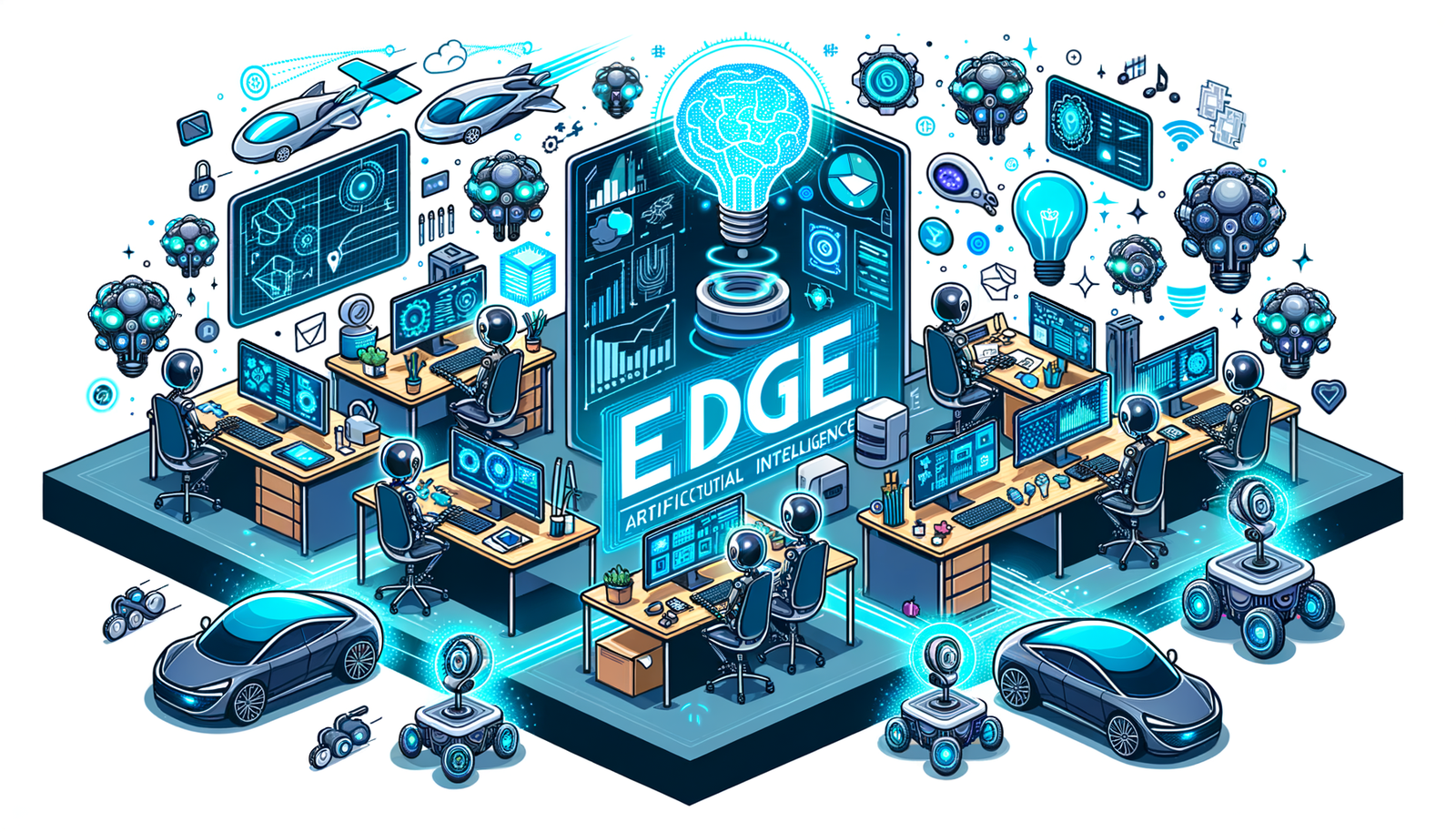Your Cart is Empty
Customer Testimonials
-
"Great customer service. The folks at Novedge were super helpful in navigating a somewhat complicated order including software upgrades and serial numbers in various stages of inactivity. They were friendly and helpful throughout the process.."
Ruben Ruckmark
"Quick & very helpful. We have been using Novedge for years and are very happy with their quick service when we need to make a purchase and excellent support resolving any issues."
Will Woodson
"Scott is the best. He reminds me about subscriptions dates, guides me in the correct direction for updates. He always responds promptly to me. He is literally the reason I continue to work with Novedge and will do so in the future."
Edward Mchugh
"Calvin Lok is “the man”. After my purchase of Sketchup 2021, he called me and provided step-by-step instructions to ease me through difficulties I was having with the setup of my new software."
Mike Borzage
Harnessing Edge AI for Real-Time Innovation in Design Processes
October 17, 2024 7 min read


Introduction to Edge AI in Design Context
Edge Artificial Intelligence (Edge AI) is revolutionizing the design industry by bringing intelligence directly to the point of data collection and action. Unlike traditional AI approaches that rely heavily on cloud computing and centralized data processing, Edge AI operates closer to the source of data, enabling real-time analytics and decision-making. In the context of design, this means that computational power is embedded within the devices and systems on-site, allowing for immediate adjustments and refinements without the latency that comes with sending data back and forth to remote servers. The significance of Edge AI in design lies in its ability to process vast amounts of data instantaneously, providing designers and engineers with the tools to make informed decisions on the spot. This immediacy is crucial in dynamic environments where conditions can change rapidly, and real-time data processing becomes essential for maintaining efficiency and accuracy. By leveraging Edge AI, designers can respond swiftly to environmental inputs, user interactions, and operational feedback, ensuring that the design process is both agile and responsive to real-world conditions. This not only enhances the quality of the final product but also streamlines the workflow, reducing delays and bottlenecks associated with traditional data processing methods.
Applications of Edge AI in Design Processes
Instant Feedback Mechanisms
One of the most impactful applications of Edge AI in design processes is the enhancement of instant feedback mechanisms. By deploying AI algorithms at the edge of the network, designers receive immediate insights into how their designs perform under various conditions. This is particularly valuable during the design phase, where real-time feedback can significantly influence the direction and outcome of a project. For instance, sensors equipped with Edge AI can analyze environmental conditions such as temperature, humidity, and structural load in real-time, allowing designers to adjust materials or structural elements accordingly. This immediacy ensures that any potential issues are identified and addressed promptly, reducing the likelihood of costly revisions later in the development cycle. Additionally, Edge AI facilitates interactive design experiences, where changes made to a model or prototype can be instantly validated against performance metrics or compliance standards. This not only accelerates the iteration process but also enhances the overall quality of the design by enabling more informed decision-making. By incorporating Edge AI, designers are empowered to create solutions that are better aligned with actual usage scenarios and environmental factors, leading to more robust and efficient designs.
Autonomous Systems Utilization
The integration of Edge AI in autonomous systems represents a significant advancement in on-site design modifications. By embedding intelligence into robotic systems and machinery, these autonomous agents can make decisions and adjustments without the need for constant human intervention or remote computational support. In the construction and manufacturing sectors, this means that robots equipped with Edge AI can perform tasks such as adjusting assembly parameters, correcting alignment issues, or adapting to unexpected obstacles in real-time. The utilization of Edge AI in autonomous systems enhances their ability to operate effectively in dynamic and unpredictable environments. For example, a robotic arm on a manufacturing floor could detect deviations in material properties and adjust its handling techniques accordingly, ensuring consistent product quality. Similarly, in construction, autonomous vehicles might navigate complex terrains while making on-the-fly adjustments to their path or construction methods based on immediate sensory input. This level of adaptability results in increased efficiency, reduced downtime, and the ability to maintain high levels of precision in tasks that are traditionally prone to human error or delay. By equipping autonomous systems with Edge AI capabilities, the design industry can achieve a new level of operational excellence and innovation.
Benefits and Challenges of Implementing Edge AI
Advantages
Implementing Edge AI in design processes offers numerous advantages that significantly enhance the efficiency and quality of design iterations. One of the primary benefits is the improved speed and efficiency in design cycles. By processing data locally and providing immediate feedback, designers can rapidly iterate on their concepts without waiting for data to be processed in the cloud. This accelerates the development process and allows for more creative exploration within tighter deadlines. Furthermore, Edge AI contributes to the reduction of errors and rework by continuously analyzing data and detecting anomalies as they occur. This proactive approach means that potential issues are identified earlier in the process, minimizing the need for costly revisions and ensuring that the final product meets the desired specifications. Another significant advantage is the enhancement of collaboration and decision-making on the design site. With Edge AI, team members can access up-to-date information and insights on-site, facilitating better communication and coordination among different stakeholders. This immediate access to data ensures that everyone is on the same page, which is crucial for making informed decisions promptly. Additionally, Edge AI supports real-time data visualization, allowing designers to interact with models and simulations on-site, which enhances understanding and fosters a more collaborative environment. Some of the key advantages include:
- Real-time data processing leading to faster design iterations.
- Immediate detection of errors, reducing rework and associated costs.
- Enhanced on-site collaboration through accessible and up-to-date insights.
- Increased adaptability to changing environmental conditions.
- Improved overall quality and performance of the final design.
Challenges
Despite the substantial benefits, implementing Edge AI comes with its set of challenges that need to be addressed to fully realize its potential. One of the significant hurdles is the technical limitations of deploying Edge AI solutions in complex and demanding environments. Edge devices often have constraints in terms of computational power, energy consumption, and storage capacity, which can limit the complexity of AI algorithms that can be executed locally. This necessitates the development of optimized models that can perform efficiently within these constraints without compromising on performance. Another challenge is the resistance to adopting new technology among traditional design teams. The shift to Edge AI requires a change in mindset and workflow, which can be met with skepticism or reluctance from professionals accustomed to conventional methods. This resistance can slow down the integration process and limit the benefits that Edge AI can bring to a project. It is essential to invest in training and change management strategies to facilitate a smooth transition and demonstrate the value of Edge AI to all stakeholders. Additionally, data security and privacy concerns are paramount when handling on-site data processing. Edge devices may be more vulnerable to security breaches, and ensuring that sensitive information is protected requires robust encryption and security protocols. Designers need to be aware of these risks and implement measures to safeguard against unauthorized access or data leaks. Key challenges include:
- Hardware limitations affecting AI performance on edge devices.
- Difficulty in integrating Edge AI into existing workflows.
- Data security vulnerabilities in decentralized processing environments.
- Potential increased costs for deploying and maintaining Edge AI infrastructure.
- Lack of standardized protocols and best practices for Edge AI implementation.
Future Prospects of Edge AI in Design
The future of Edge AI in design is promising, with numerous developments on the horizon that are set to further transform the industry. Predictions indicate that Edge AI technologies will continue to evolve rapidly, becoming more powerful and efficient, which will expand their applications in design workflows. The integration of Edge AI with other emerging technologies such as the Internet of Things (IoT) and 5G networks is particularly noteworthy. The proliferation of IoT devices means that more data is generated at the edge than ever before, and Edge AI is essential for processing this data in real-time to derive meaningful insights. The advent of 5G technology plays a crucial role in enhancing Edge AI capabilities by providing faster and more reliable connectivity. This enables seamless communication between devices and systems, supporting more complex and resource-intensive AI applications at the edge. With reduced latency and higher bandwidth, designers can leverage Edge AI to create more interactive and responsive design environments, bridging the gap between digital models and real-world implementation. Furthermore, Edge AI has the potential to empower sustainable and adaptable design practices. By providing immediate feedback on environmental impact and resource utilization, designers can make more informed decisions that promote sustainability. Edge AI can monitor and adjust systems in real-time to optimize energy consumption, reduce waste, and enhance the overall efficiency of operations. This aligns with the growing emphasis on environmentally conscious design and the need to address global challenges such as climate change. Looking ahead, we can expect:
- Greater integration of Edge AI with smart materials and adaptive systems.
- Advancements in edge computing hardware, enabling more complex AI models.
- Development of standardized frameworks for Edge AI deployment in design.
- Increased collaboration between technology providers and design professionals.
- Expansion of Edge AI applications into new areas such as urban planning and virtual reality.
Conclusion
In conclusion, Edge AI represents a transformative force in the realm of on-site design adjustments. By bringing intelligent data processing directly to the source, it enables a level of immediacy and responsiveness that is unparalleled by traditional AI approaches. The benefits of integrating Edge AI into design processes are manifold, including improved efficiency, reduced errors, and enhanced collaboration. As the technology continues to advance, it is poised to play a critical role in driving innovation and excellence within the industry. Design professionals are encouraged to embrace Edge AI as a means of elevating their work and staying competitive in an ever-evolving landscape. By adopting these technologies, designers can unlock new possibilities, streamline their workflows, and deliver higher-quality outcomes. The potential of Edge AI extends beyond mere efficiency gains; it offers a pathway to more sustainable, adaptable, and intelligent design practices that are responsive to the needs of both clients and the environment. It is imperative for industry stakeholders to invest in and explore the integration of Edge AI solutions in their design processes. This requires a collaborative effort to overcome the challenges associated with implementation, including technical limitations and resistance to change. By prioritizing education, fostering innovation, and supporting the development of robust Edge AI infrastructure, the design industry can fully leverage the transformative potential of this technology. The journey towards widespread Edge AI adoption is not without its hurdles, but the rewards in terms of productivity, innovation, and sustainability make it a worthwhile endeavor.
Also in Design News

Cinema 4D Tip: Matrix-Driven Instancing for High-Performance Scattering
December 20, 2025 2 min read
Read More
V-Ray Tip: V-Ray Anisotropy Techniques for Brushed Metals and Hair
December 20, 2025 2 min read
Read More
Revit Tip: Revit Nested Tagging: Shared Nested Families and Roll-Up Parameters
December 20, 2025 2 min read
Read MoreSubscribe
Sign up to get the latest on sales, new releases and more …


